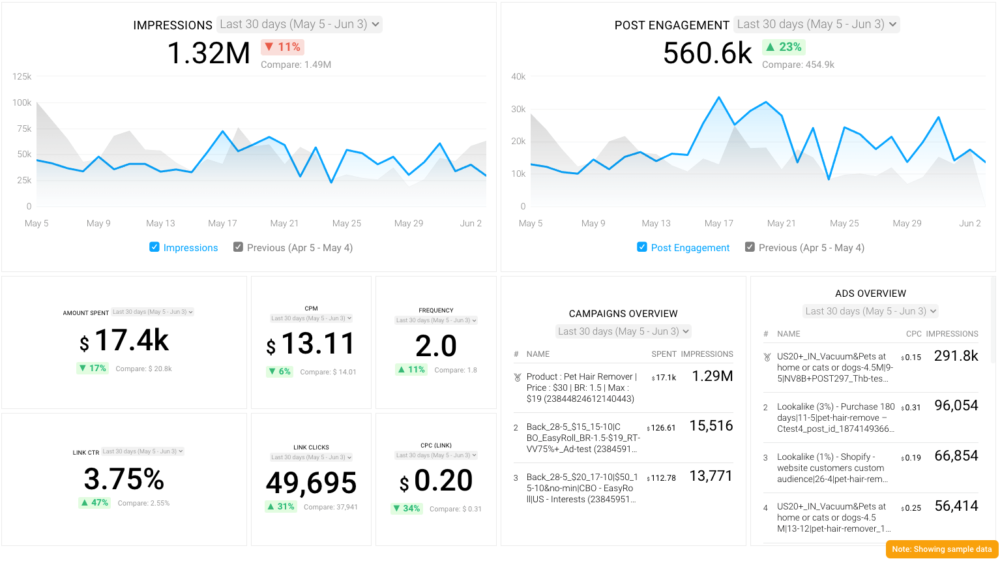Table of contents
Did you know that 85% of Facebook video ads are watched with no sound?
Or, that 50% of Facebook’s mobile ad revenue comes from video ads?
And, that it costs 7.5% less to use a square Facebook video ad instead of one in landscape mode?
Statistics like these can help you not only maximize the reach of your video ads but drive more conversions.
Considering, SMBs polled in this study on Facebook ads performance say video ads have been the most effective for them, we sought to help you attain similar amount of success with yours.
So, in this post, we’re sharing 26 tactics to help you generate more conversions from your Facebook video ads, including:
- Identify your primary conversion metric
- Create different ads based on where people are in the customer journey
- Produce videos that you would actually want to watch
- Get to the point quickly
- Create pattern interrupts
- Test multiple versions of your opening scene
- Pose a question at the start of your video ad
- Help people visualize the experience of using your product
- Include a compelling call-to-action
- Provide an irresistible hook
- Be concise
- Make your video ad shareworthy
- Create an emotional connection with the viewer
- Set up proper targeting
- Optimize your video for smartphone viewers
- Create different versions of the same video for different Facebook ad placements
- Use eye-catching visuals
- Use subtitles
- Test multiple video thumbnails
- Write an engaging headline and ad copy
- Choose the video views objective
- Demonstrate expertise and credibility
- Use 360-degree content
- Make sure your video pops
- Optimize your ad landing pages
- Use standard events instead of custom conversions
1. Identify your primary conversion metric
Before you start creating any video ad campaigns, you must first define the goal of your company.
According to our survey, we found that nearly 40% of marketers’ primary conversion metric is new leads.
However, as TJ Kelly of RaySecur, Inc explains, leads might not be the right metric in your case. Measuring post engagement or website visits might make more sense.
“Videos, especially on consumption-heavy platforms like Facebook, do not convert in the traditional sense,” says Kelly. “That is, they don’t lead many users to provide their email address to become a lead.
However, if you define conversion as something more TOFU (top of funnel), like subscribe to/interact with a brand channel or join a social media group, then video has an excellent conversion rate.
Set expectations properly, and plan/promote your video content appropriately—and your Facebook video campaigns will be set up well to succeed.”
PRO TIP: What’s the overall engagement of your ad campaigns?
Want to make sure your Meta ads are performing and trending in the right direction across platforms? There are several types of metrics you should track, from costs to campaign engagement to ad-level engagement, and so on.
Here are a few we’d recommend focusing on.
- Cost per click (CPC): How much are you paying for each click from your ad campaign? CPC is one of the most commonly tracked metrics, and for good reason, as if this is high, it’s more likely your overall return on investment will be lower.
- Cost per thousand impressions (CPM): If your ad impressions are low, it’s a good bet everything else (CPC, overall costs, etc.) will be higher. Also, if your impressions are low, your targeting could be too narrow. Either way, it’s important to track and make adjustments when needed.
- Ad frequency: How often are people seeing your ads in their news feed? Again, this could signal larger issues with targeting, competition, ad quality, and more. So keep a close eye on it.
- Impressions: A high number of impressions indicates that your ad is well optimized for the platform and your audience.
- Amount spent: Tracking the estimated amount of money you’ve spent on your campaigns, ad set or individual ad will show you if you staying within your budget and which campaigns are the most cost-effective.
Tracking these metrics in Facebook Ads Manager can be overwhelming since the tool is not easy to navigate and the visualizations are quite limiting. It’s also a bit time-consuming to combine all the metrics you need in one view.
We’ve made this easier by building a plug-and-play Facebook Ads dashboard that takes your data and automatically visualizes the right metrics to give you an in-depth analysis of your ad performance.
With this Facebook Ads dashboard, you can quickly discover your most popular ads and see which campaigns have the highest ROI, including details such as:
- What are your highest performance Facebook Ad campaigns? (impressions by campaign)
- How many clicks do your ads receive? (click-through rate)
- Are your ad campaigns under or over budget? (cost per thousand impressions)
- What are your most cost-efficient ad campaigns? (amount spent by campaign)
- How often are people seeing your ads in their news feed? (ad frequency)
And more…
You can easily set it up in just a few clicks – no coding required.
To set up the dashboard, follow these 3 simple steps:
Step 1: Get the template
Step 2: Connect your Facebook Ads account with Databox.
Step 3: Watch your dashboard populate in seconds.
2. Create different ads based on where people are in the customer journey
The ads that you create and surface will also vary based on which phase a prospect or customer is in.
For example, if people don’t even know that they have a problem – let alone that your product or service exists- it makes sense to run brand awareness campaigns to educate them.
Build a custom audience to educate people on your products
“The biggest tip of all is that you don’t need to drive conversions from video ads,” says Morgan Taylor of LetMeBank. “Instead you should build an audience using cheap video ads, then retarget that audience using a link based ad.”
Syed Faizuddin of MakeWebBetter adds, “While creating a Facebook Video Ad, think twice about your audience. If your audience doesn’t know about your product, promoting the product directly will not help you in sales. Thus, instead of pitching them directly for sales, educate them first. They should feel that your product is the actual solution of their problem. And make sure that your video ad is focused on specific product features that will solve their problem.”
Create retargeting ads to the most engaged viewers
Daniella Pozzolungo of PupDigital says, “I love retargeting video viewers as the more engaged they are with the brand, the more likely they are to convert. Look at how many people viewed your videos at different stages (i.e. 10%, 50%, 95%) and create ads to the most engaged people. You want to make sure that the list is quite big, so if you don’t have many people at 95%, perhaps look at 50%. Also, keep in mind views on the audience network are not able to be remarketed to, so you might want to remove the audience network from your placements if you want to remarket to everyone who views your video.”
Nancy Kapoor of Grazitti Interactive adds, “Always segment your target audience into smaller niche audiences with region-specific and deliver highly customized ads that are tailored to each group.
You can create custom audiences of those that viewed 75% of the video or 50% of the video and bid differently to these two groups based on their level of engagement they pose. This will increase the productivity of your campaign and will also save your marketing budget.”
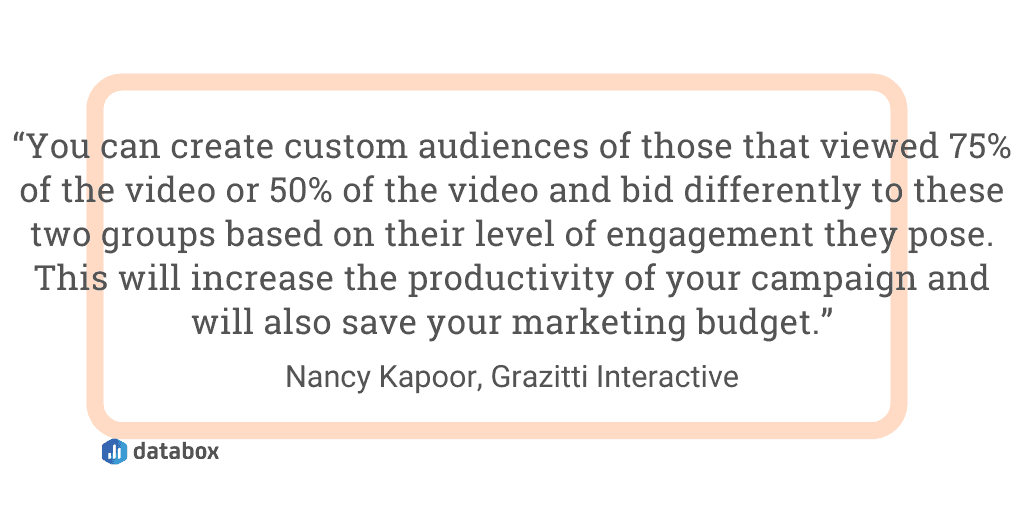
3. Produce videos that you would actually want to watch
This might sound obvious, but regardless of what type of video ad you are running, the video still has to be worth watching.
Michael Alexis of Tea vs Coffee says, “Our rule of thumb for creating Facebook Video Ads is to create content we would actually want to watch. The goal isn’t to trick someone into watching our video, it is to share a message that so deeply connects with them that they want to watch it and learn more. We are fortunate that the subjects, tea, and coffee, have a pretty strong fan base around the world!”
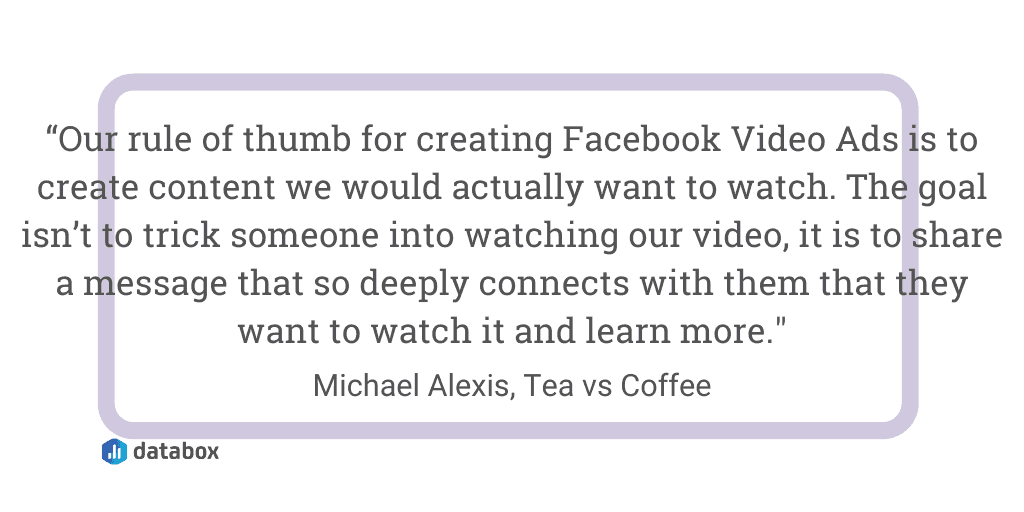
Philip Toussaint of Nomads With Solutions adds, “One tip is that the video you are using for the campaign has high-quality images. If there is music, text overlays, or a voice-over, that must be high quality and clean as well. Facebook will optimize for those videos better and they will have more overall reach and more likely to convert with your target audience.”
4. Get to the point quickly
“My biggest tip is to get to the point within the first eight seconds of playtime,” says Nicole Fikes of Merrygood. “That’s the average viewership of most videos on Facebook, so if you’ll want to put your biggest selling point first.”
Gil David of Run DMG says, “Grab attention within the first SECOND or users will lose interest and keep scrolling. This usually means some kind of eye-catching movement, visuals that stand out or something out of the ordinary that entices people to keep watching.”
David Denning of Jumpstart Go agrees, “If you don’t capture their interest in the first 3-5 seconds, you’ve lost the opportunity to tell them more and drive them to the next action.”
Nicole Suther of Human Marketing adds, “Your video needs to capture your audience’s attention within the first 3 seconds or less. Engaging video content will make people stop and view your video. While grabbing the viewer’s attention, if your video has sound, you will need to add captions. The majority of videos are viewed without sounds, so if you have an important message, then always add captions. It’s also a good way to make your videos accessible to people who are hearing-impaired.”
“In the same vein as any video content, your ads should front-load value,” says Alexander Porter of Search It Local. “With the fluid nature of social media, and your ad sliding into oblivion with a swipe of the finger, you need to hit your target audience hard and fast with both visuals and value.
Don’t assume they’ll hang around until the end for your payoff.
Assume they are on a train, about to get off, late for work, chasing a project deadline, and didn’t get their morning coffee.
THAT is your target. Someone with so little time your ad HAS to grab them and hold them tight.
You have all the time in the world to make your ad, all the testing groups, and all the feedback you need. So it’s easy to think your audience does too.
If you start seeing your ads as existing within the wider framework of a busy customer, you’ll be better placed to give people what they want – and need – upfront.”
Dylan Carpenter of Koality Media recommends taking this a step further.
Carpenter says, “We love videos that include people enjoying the product as well as the customers’ problems being solved. We also typically include reviews in the video itself.”
David Weaver of Vintage Cash Cow explains, “There needs to be an immediate benefit-driven impact on the user in the first few seconds, or they’ll just keep scrolling.
The more narrow the audience, the more specific the messaging can be.
The user needs to make a connection instantly between the piece of content in front of them and they’re own pre-existing beliefs, needs, pains, wants, vices etc.
Example: Chiropractor runs a Facebook ad to a 20-second video. Audience; Over 50-year-olds in Leeds, UK.
“Here at DW chiropractors, we’ve been treating our loyal customers for over 30 years. We provide the best support and treatment for a huge range of pains, aches and injuries … x y z etc.” zzz snoring.
Vs
Audience 60-65 yr old males in Leeds, UK
“Back pain? Shoulder playing up? Hip causing you problems? Don’t leave it any longer, I will fix this for you. Come and see me this week for a free consultation… xyz etc.”
5. Create pattern interrupts
“My ultimate tip for creating high-converting Facebook video ads is making sure you capture your audience’s attention within the first 2 seconds of your video using pattern interrupts,” says Khris Steven of Khrisdigital.com. “This will grab their attention and make them curious about what’s next.
An example of pattern interrupts could be like telling them you’d like to show them something, then you take a walk to show them or try to reveal a concealed information or stuff. Another good example is starting with a question.
Just keep in mind that someone who waited for 2 seconds to watch your video is likely to hold on to watch 10 seconds, then 30 seconds, and so on.
So make the beginning count.”
6. Test multiple versions of your opening scene
“Test your intro scene with as many variations as possible,” says Brett Friedman of Marpipe. “It’s the first scene that becomes your ads thumbnail. It’s the thumbnail that drives all your traffic.”
7. Pose a question at the start of your video ad
“Do not open with aspirational drone footage or a fancy intro,” says Dale Johnson of Nomad Paradise. “You have pretty much a second to grab attention. Pose a question that entices the viewer to keep watching. This question needs to address something the audience cares about, or what to find a solution to. In your first several seconds, pair this bold text with quick-cut footage to help jump out of the feed. Only once you’re 5-6 seconds in should you slow the pace down, while continuing on the path to the solution.”
8. Help people visualize the experience of using your product
“Create a sensory video ad that creates the illusion of experiencing the product or service through the ad,” says Elmer Taboada of DaVinci Tech. “When your video ad successfully does that, you can expect curious customers to click on your website to learn more.”
9. Include a compelling call-to-action
“Include a call-to-action in the beginning,” says Jackie Kossoff says. “Let your audience know what the video is all about and then go on to explain.”
Lennart Meijer of The Other Straw adds, “Be concise with your CTA and the next steps to be taken for your prospect.”
For example, Aristide Basque of SH1FT says, “Maybe it’s explaining a feature or how easy it is to use your product.”
Jasmine Hippe of Augurian adds, “Include a strong call-to-action in your video that tells viewers what they should do next. This can be something along the lines of, ‘call us today’ or ‘browse more products on our website,’ but be clear about what actions viewers should take next.”
Bryan Wisotsky of Alphametic says, “Make sure there’s a button which links to a landing page to achieve your KPI whether it be a from full, phone call, or purchase.” See if your CTAs are generating the desired results using these social media dashboards.
10. Provide an irresistible hook
“You have to have a hook or an irresistible offer,” says Tom Beckerle of JWeb Media. “People get on Facebook to get away from making decisions. It’s your job to generate enough interest for someone to take action.”
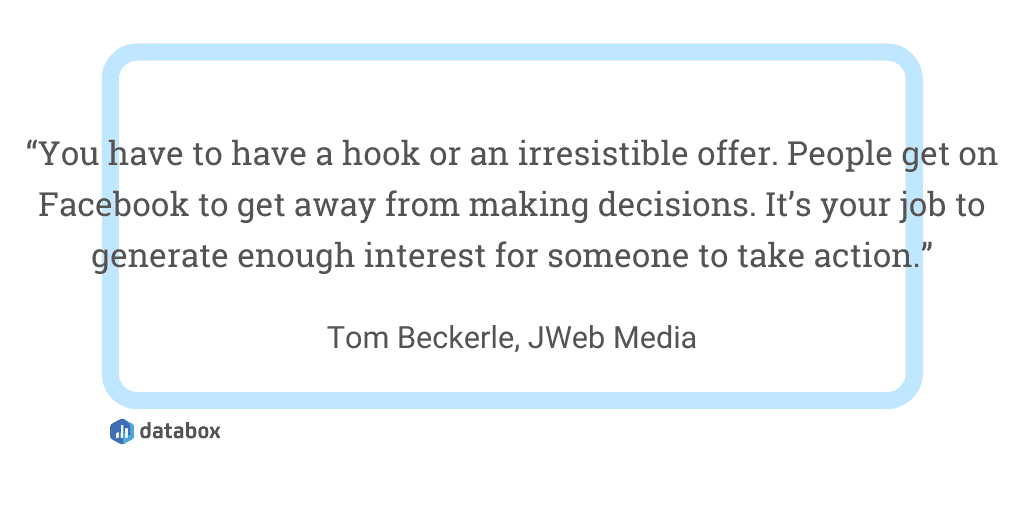
James Robinson of Iconic Genius says, “Think of your video ad as a funnel. You want to lead users to the end of it with a call to action. But first, it starts with grabbing attention. So, the first 3 seconds are the most important.
Don’t waste the time and effort by taking 10 seconds to show the logo or intro a product. Get right into the benefit or actionable step!
You want your video to WOW people in the first 3 seconds. And then the next 3 and so on and so forth until they reach the end.
By that time your customer will have already scrolled past your ad.”
Duncan Pacey adds, “The best thing a marketer can do when making Facebook video ads is remember one thing: nobody wants to watch them. Nobody logs onto Facebook thinkings, man, I really want to see that ad (unless it’s something super viral, like Dollar Shave Club – but then people would seek that on YouTube, not Facebook ads). So no matter how much money you put into your video, your retention is likely going to be pretty poor. You have to think in terms of grabbing someone’s attention not in 30 seconds, not in 15 or 10, but in 3-5 seconds. If you can stop someone’s thumb in just 3 seconds, you increase that chance of ad recall and, if your supporting copy, headline, and link description are stellar as well, getting that click-thru. Therefore, when making your ad, ask if it grabs attention literally instantly because if it doesn’t, someone else’s might.”
11. Be concise
“One tip to creating Facebook Video Ads that drive conversions would be to create ads that are less than 10 seconds,” says Anjana Wickramaratne of Active Digi Solution. “This will allow you to grab your target audience’s attention within seconds. Also, if you are using this 10-second technique, there are some very important things to remember. The first one is to add all relevant information to the video as it is short and viewers plan on seeing only what is necessary. The second one is to edit the video with quick transitions to grab the attention of the target audience. The third and final thing to keep in mind is to give a strong call to the action button as you have the attention of the viewer and you need to act quickly on that interest of the viewer before the viewer loses attention.”
Victoria Pierre of MyCarInsurance123.com says, “When it comes to effective Facebook video ads, short and to the point should always be your priority. This day and age, most users have short attention spans, especially if they’re on mobile.”
Jeremy Cross of Virtual Team Building Company agrees, “Make short and punchy videos. The amount of attention you get on social media is usually measured in seconds or even micro-seconds. If you can start with video content that seems fun and energetic than people will give you a little more time. That extra time is helpful for pitching the benefits of your product or service.”
Subhash Rao of Digi Elephant adds, “Keep your video ads concise. Facebook users are inundated with all types of content in their News Feeds. From friendly posts to memes, competitor ads to funny videos, you can typically expect to capture only about 60 seconds of your audience’s attention.
That’s why it’s so important that your video ads are succinct and easy to understand. If you’re not capturing their attention as soon as possible, viewers won’t stick around!
Front-load video ads with the most important information first. If you don’t get to the point quickly, it’s very likely that users won’t watch the video to the point where they understand the value your product provides. Showcase this value as soon as possible.
Be specific with each ad. If you include too much information in a single video, it’s easy to lose focus, which makes the video less engaging. Focus on a single theme in every video; don’t try to communicate more than necessary.
Make it personal. When you appeal to Facebook users’ emotions, it’s easy to make a connection that lasts.”
Editor’s Note: Measure the effectiveness of your video ad campaigns using our Facebook Video Completion Metrics Dashboard.
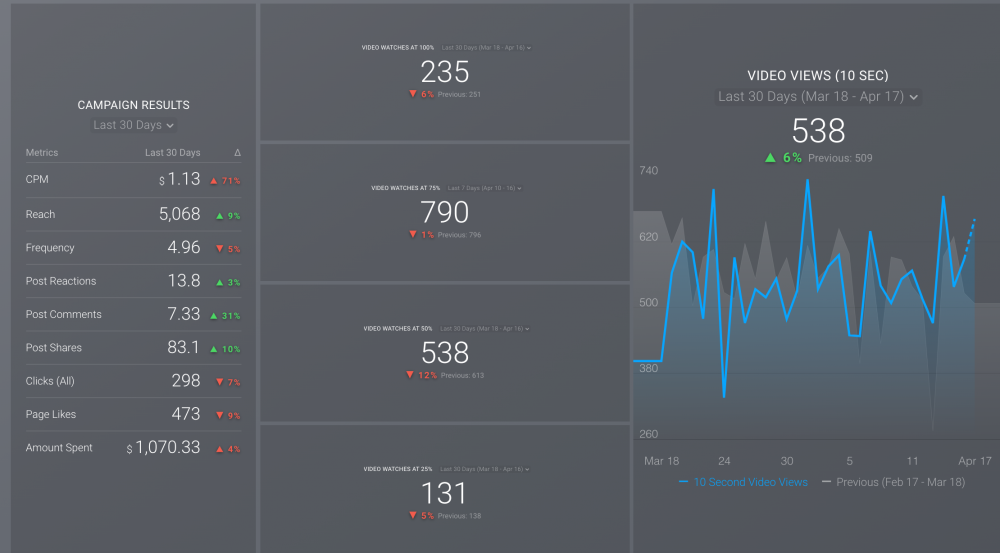
12. Make your video ad shareworthy
“I recommend making the content worthy of sharing for the audience,” says Adrian Wille of Media Link, Inc.. “Include educational or entertaining elements and don’t focus too much on the sale (exceptions apply). Once the video ad is shared by a friend it becomes a trusted referral instead of a rather anonymous pitch.”
13. Create an emotional connection with the viewer
“Be authentic to your brand and show your true brand essence,” says Adelina Emmi of Modish Social. “In such a saturated market, it’s so important that you tell your story in an authentic way to create an emotional connection to the audience.”
14. Set up proper ad targeting
“When it comes to Facebook advertising, it’s all about targeting,” says Julian Lupo of Quillin. “We have the remarkable ability to serve ads to the exact people who need to see them in order to drive conversions. Perfecting your audience targeting will take time and research. It’s a trial and error process, but once you find that perfect mix, your ads will convert at a higher rate.”
Caroline Scholten of Chocolate Films says, “Create a specific audience for your ad. Make sure you target the right people who you think would be interested in your video, You can target people by location, age, gender, and interests. So, make the most of it! It’s all about putting your video in front of the right people, not the most people.”
Daisy Jing of Banish adds, “You can use Facebook to target very specific audiences. Facebook collects a lot of data for you, much more data than you think they have. Because they have all this data, they can create very precise targeting.”
Patrick Hodgson of AdMax Local recommends taking this one step further,
“One of my favorite tips to offer clients and peers that want to successfully drive conversions and improve spend efficiency with Facebook Video Ads is to make sure that the targeted audience is represented in the video,” says Hodgson. “The tactic allows for the ads to become more relevant to the audience, which translates to more top of the funnel activity like clicks and average watch time. Increases in activity at the top of the funnel set up better retargeting and lookalike campaigns to drive conversions.”
15. Optimize your video for smartphone viewers
“Users on Facebook are more engaged with video on-the-go rather than captivated viewing,” adds Gabe Hernandez of ROI Swift. “That means users have short, frequent, and unplanned sessions compared to more intentional and relaxed viewing for entertainment. This means that we recommend designing videos for mobile – quick, sticky, engaging, fun, optimized for sound off, and the brand front and center within the first 3 seconds.
We primarily are measuring videos by looking at the video average watch time to understand what percentage of the video the average user watches in order to see how sticky the video actually is.”
16. Create different versions of the same video for different Facebook ad placements
Adrian Rafter of Quad Lock says, “I like to keep videos short, say around 6 seconds, and create different versions of the same video for all the different placement sizes Facebook offers.”
Jess McClory of Logic Digital adds, “Have a rotation of videos that you can use to test different variables (such as length, content, CTA) as this will help you determine what works best for your audience and speed up the time it takes to succeed in future campaigns.”
17. Use eye-catching visuals
“The best way to boost conversions when creating Facebook Video Ads is by using eye-catching visuals,” says Joel Almazar of Upgrow. “Studies show that it takes less than 3 seconds for a person’s sight to choose where it will land on a webpage. This is why you need to choose images that will attract a person’s attention and create a good first impression.
How can you do this? Do not add too much text to your images as this will make the person feel lazy for checking out your video. Believe it or not, most people find reading to be tasking.
You should also make use of high-resolution images. Choose the best size for your image to make it look more professionally done as it will reflect on your brand.”
Hellen Pham of AdVisible adds, “Use bright, fast, and eye-catching graphics that are in square or portrait format. On social, you are competing for attention so you want to make an impression in the first few seconds. Creating your video in a portrait or square format takes up more ad real estate, making it more visible and appears native to the platform.”
18. Use subtitles
“The biggest tip that I give students about Facebook video ads is to make sure that the video being used is very clear and to the point,” says Tzvi Fried of Mylogomotive.com. “One way to ensure this is to make sure the video has subtitles with a clear message as many people scroll through Facebook with their volume off.”
Laura Bean of THAT Agency says, “When creating Facebook Video Ads, it is extremely important to have captions for any videography that has captions. More than two-thirds of users watch video from their phones without sound.”
Melanie Musson of CheapCarInsuranceQuotes.com agrees, “If someone wants to watch a video in silence and you have no captions, they’ll move along to something else. A large portion of Facebook users don’t use audio with video. So caption your video with what your audience needs to know.”
Meara McNitt of Online Optimism adds, “Many users are scrolling at times when listening isn’t an option. If your ad isn’t accessible silently, then it’s likely to be looked over. Use Facebook’s free caption editor while creating your ad, or use a subscription service like Kapwing.”
In addition, video ads don’t have the same text restrictions as image ads. So, you don’t have to worry about adding subtitles that will tip it over the 20% image text rule.
“Don’t worry about any text rules,” says Brian Davidson of Matchnode Digital Marketing. “You can create and upload a separate thumbnail image so your ad won’t be throttled/disapproved.”
Andrew Glasser of Circa Interactive, Inc. adds, “ In cases like Facebook, rules restrict the amount of text that image advertisements can contain without being penalized. With GIFs and videos, the permitted amount of text is much greater than the 20% you can put into a single frame image. This means you can add a significantly higher amount of information on your program and what you’re trying to advertise. Adding text as part of the creative design is ideal; at an absolute minimum, you should include subtitles with your video.
19. Test multiple video thumbnails
Orlando Rios of Dropkick Ads adds, “Test multiple thumbnails. Recent tests show that video thumbnails can have a major impact on click-through rate.”
20. Write an engaging headline and ad copy
“If you want your audience to actually watch your video ads, you must have an engaging title and description that tells people what they should expect to see,” says Ashok Sharma of Signity Solutions.
21. Choose the video views objective
“Whenever you are creating a Facebook video ad, make sure you choose video views as your objective,” says Alejandro Rioja. “This enables Facebook to target people who are more likely to watch your video i.e your ad reaches the right custom audience for your campaign.”
22. Demonstrate expertise and credibility
“Offer solid evidence and credibility – a video can be used to demonstrate how a product or service works,” explains Diane H. Wong of DoMyWriting. “It can offer customer reviews or social proof (testimonials). When a video offers proof, the message is perceived as providing solid evidence of the product’s ability to solve a particular problem and being simple to use for example. It sets off emotional triggers, which ultimately influence buying decisions.”
Maninder Paul says, “Add human touch to your video ads through customer testimonials. They are one of the most valuable forms of user generated content (UGC) to build credibility, authenticity, and increase conversions. Testimonials help your brand leverage positive experiences, effectively communicate benefits products and services, and create a personal connection with your target audience. Some examples of brands using customer testimonials are ZenDesk, Hello Fresh, Salesforce, and Slack.”
23. Use 360-degree content
“Use of 360-degree content,” says David Roberts of ReVerb. “It provides breathtaking immersion and an unforgettable experience for viewers. Users seem to be transferred to the picture that they see, reduces the distance between them and a brand/product.
360-Degree Content is one of the most effective ways to present the product in detail via Facebook ads and motivate buyers to purchase it. It’s a real lead generation machine that drives conversions.”
24. Make sure your video pops
“Standout in the feed,” says Torrey Tayenaka of Sparkhouse. “Remember Facebook viewers are on there to check up on friends and family not to watch ads. You need to make sure to stop the scroll with something visually exciting or shocking.”
25. Optimize your ad landing pages
“While creating Facebook Video Ads, ensure that your landing page has all the information to attract customers,” says Venkatesh C.R. of Dot Com Infoway. “Start by conducting thorough research on your audience.” Measure the effectiveness of your ad landing pages using this social media dashboard software.
26. Use standard events instead of custom conversions
“To ensure that your Facebook video ads drive sales and conversions, make sure that you’re using standard events to optimize each step of your campaign (rather than custom conversions),” says Natacha Kenol of Kenol Marketing. “Facebook has access to data from millions of advertisers using standard events (as of 2019, there were over 7 million active advertisers on Facebook), and this will help Facebook optimize your campaigns more efficiently. For example, you’ll want to make sure that you’ve set up standard events for View Content, Add to Cart, Initiate Checkout, and Purchase steps of your advertising funnel. This can be done in your Events Manager.”
In sum, Facebook video ads can be one of the most cost-effective advertising methods for driving new conversions. Using these 26 tips can help you optimize your ad campaigns.






